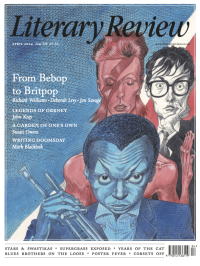Lucy Moore
Off with Their Petticoats
Liberty Equality Fashion: The Women Who Styled the French Revolution
By Anne Higonnet
W W Norton 304pp £25
After they were released from prison in Paris in the late autumn of 1794, both having narrowly escaped the guillotine, new bosom friends Rose de Beauharnais and Térézia Tallien found they had nothing to wear. Dressmakers and milliners had all but disappeared from a city still reeling from the Reign of Terror. In an era of desperate need and rampant inflation, a time when even the most prosperous took candles and bread with them when they went out to dinner, who could afford a silk dress, still less stays, hoops, acres of petticoats and several maids to sew you into it?
The new feminine uniform they devised, making a stylish virtue of necessity, was simple, based on cotton chemises previously worn as underwear. In Liberty Equality Fashion, the art historian Anne Higonnet breaks down its creation into stages: over a period between 1794 and 1796, the multi-part formal gown became a single-part frock; sashes crept upwards from the waist to just beneath the bust; petticoats were abandoned. In 1788 a single party dress might have cost 150 livres. Eight years later, the entire wardrobe of Rose de Beauharnais, by now married to Napoleon Bonaparte and known as Joséphine, was worth not quite five times that, giving her eighteen mostly cotton dresses a rough value of thirty livres each.
Higonnet focuses on the period immediately after the Terror, and particularly on the clothes worn by three young women: Rose de Beauharnais, Robespierre’s beautiful nemesis Térézia Tallien, and the virginal seductress Juliette Récamier.
Each of the ‘Three Graces’, as they were called, had endured hard times before their social triumph

Sign Up to our newsletter
Receive free articles, highlights from the archive, news, details of prizes, and much more.@Lit_Review
Follow Literary Review on Twitter
Twitter Feed
Although a pioneering physicist and mathematician, Blaise Pascal made it his mission to identify the divine presence in everyday life.
Costica Bradatan explores what such a figure has in common with later thinkers like Kierkegaard.
Costica Bradatan - Descartes Be Damned
Costica Bradatan: Descartes Be Damned - Blaise Pascal: The Man Who Made the Modern World by Graham Tomlin
literaryreview.co.uk
The era of dollar dominance might be coming to an end. But if not the dollar, which currency will be the backbone of the global economic system?
@HowardJDavies weighs up the alternatives.
Howard Davies - Greenbacks Down, First Editions Up
Howard Davies: Greenbacks Down, First Editions Up - Our Dollar, Your Problem: An Insider’s View of Seven Turbulent...
literaryreview.co.uk
Johannes Gutenberg cut corners at every turn when putting together his bible. How, then, did his creation achieve such renown?
@JosephHone_ investigates.
Joseph Hone - Start the Presses!
Joseph Hone: Start the Presses! - Johannes Gutenberg: A Biography in Books by Eric Marshall White
literaryreview.co.uk